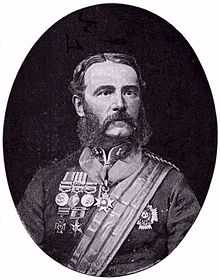Henry Tombs
| Henry Tombs | |
|---|---|
 | |
| Born |
10 November 1825 Calcutta, British India |
| Died |
2 August 1874 (aged 48) Newport, Isle of Wight |
| Buried at | Carisbrooke Cemetery |
| Allegiance |
|
| Service/branch |
Bengal Army British Army |
| Years of service | 1841 - 1872 |
| Rank | Major General |
| Unit | Bengal Horse Artillery |
| Commands held | Royal Horse Artillery |
| Battles/wars |
Siege of Delhi First Anglo-Sikh War Second Anglo-Sikh War Bhutan War Indian Mutiny Gwalior Campaign Battle of Punniar Battle of Moodkee Battle of Aliwal Battle of Ramnagar Battle of Chillianwallah Battle of Goojerat Battle of Budleekesera Battle of Nujjufghur |
| Awards |
Victoria Cross Order of the Bath Indian Mutiny Medal India General Service Medal Sutlej Medal Bronze Star Sutlej Medal |
Major General Sir Henry Tombs VC KCB (10 November 1825 – 2 August 1874) was a recipient of the Victoria Cross, the highest and most prestigious award for gallantry in the face of the enemy that can be awarded to British and Commonwealth forces.
Early life
Henry Tombs was born in Calcutta, India on 10 November 1825. He was the youngest of seven to Major General John Tombs and Mary Remington. He was sent back to England for an education during which time he studied at Abingdon School. At the age of 14 he entered the East India Company's Seminary at Addiscombe, graduating in June 1841 and receiving a commission in the Bengal Horse Artillery. In 1869 he married Georgina Janet Stirling, the youngest daughter of Admiral Sir James Stirling. Their grandson Joseph Tombs received the VC for actions during World War I.
Military career
Henry Tombs received his first commission as second lieutenant in the Bengal Horse Artillery on 11 June 1841 and first saw active service aged 18 during the Gwalior Campaign. He first distinguished himself whilst fighting at the Battle of Punniar with the No.16 Light Field Battery (horsedrawn) and was awarded the Bronze Star in 1843.
During the First Anglo-Sikh War (1845–1846) Henry Tombs became Aide-de-Camp to Lieutenant General Sir Harry Smith and was present at the Battle of Moodkee, the Battle of Ferozeshah and the Battle of Aliwal. He was awarded a Sutlej Medal with two clasps (for Ferozeshuhur and Aliwal) in 1848.
During the Second Anglo-Sikh War (1848–1849) Henry Tombs was promoted to Deputy Assistant Quartermaster General of Artillery and was present at Battle of Ramnagar, the Battle of Chillianwallah and the Battle of Goojerat. He received the Punjab Medal with two clasps (for Chillianwallah and Goojerat) and was subsequently promoted Major.
Henry Tombs' saw service for a fourth time during the Indian Mutiny during which he commanded a troop of Horse Artillery. On 31 May 1857 his horse was shot from beneath him for a first time. He fought at the Battle of Budleekeserai where two horses were shot from under him. Tombs was also present at the Siege of Delhi during which he commanded the Bengal Horse Artillery. It was during this siege, on 9 July 1857 that he performed the act of gallantry for which he was to be awarded the Victoria Cross.
Victoria Cross
At the age of thirty-one, when a major in the Bengal Horse Artillery, Bengal Army during the Indian Mutiny, the following deed took place at the Siege of Delhi for which he and James Hills were awarded the VC:
Lieutenant-Colonel Henry Tombs, C.B., and Lieutenant James HillsDate of Act of Bravery, 9th July, 1857
For very gallant conduct on the part of Lieutenant Hills before Delhi, in defending the position assigned to him in case of alarm, and for noble behaviour on the part of Lieutenant-Colonel Tombs in twice coming to his subaltern's rescue, and on each occasion killing his man.
(See despatch of Lieutenant-Colonel Mackenzie, Commanding 1st Brigade Horse Artillery, dated Camp, near Delhi, 10th July, 1857, published in the Supplement to the London Gazette of the 16th January, 1858.)[1]
The medal
His Victoria Cross is displayed at the Royal Artillery Museum, Woolwich, London.
References
- ↑ The London Gazette: no. 22131. p. 2050. 27 April 1858. Retrieved 26 September 2009.
- Monuments to Courage (David Harvey, 1999)
- The Register of the Victoria Cross (This England, 1997)
- Scotland's Forgotten Valour (Graham Ross, 1995)
- Tombs of Abingdon (Nigel Hammond, Oxfordshire Family Historian, December 2004)
- "Memoir of Major-General Sir Henry Tombs" (Royal Artillery Institution, 1913)
- "Memoir of Major General Sir Henry Marion Duran" (Volume 1, 1883)
- "The New Army List; The Bank, Standing, and Various Services Regimental Officer in the Army Serving on Full Pay, Including the Royal Marines and Indian Staff Corps" (1869)
- "The memoirs of the Gemini Generals: personal anecdotes, sporting adventures, and sketches of distinguished officers" (A. D. Innes, 1896)
- "Dictionary of National Biography" (1885–1900, Volume 57)
- Vibart, H.M. (1894). Addiscombe: its heroes and men of note. Westminster: Archibald Constable. pp. 517–19.
External links
- Location of grave and VC medal (Isle of Wight)
- (East India Company Births)
- s:Tombs, Henry (DNB00) "Dictionary of National Biography" (1885–1900, Volume 57)